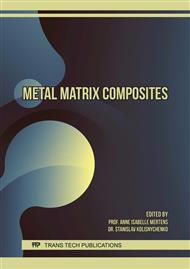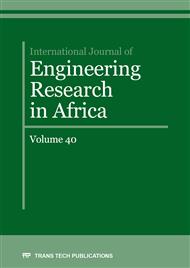[1]
H. Sahasrabudhe, S. Bose, A. Bandyopadhyay, Laser-Based Additive Manufacturing Processes, Advances in Laser Materials Processing, 17 (2018) 507-539.
DOI: 10.1016/b978-0-08-101252-9.00017-0
Google Scholar
[2]
D. Bourell, J. P. Kruth, M. Leu, G. Levy, D. Rosen, A. M. Beese, A. Clare, Materials for additive manufacturing, CIRP Annals – Manufacturing Technology, 66 (2017) 659-681.
DOI: 10.1016/j.cirp.2017.05.009
Google Scholar
[3]
D. B. Miracle, Metal matrix composites from science to technological significance, Composites Science and Technology, 65 (2005) 2526-2540.
DOI: 10.1016/j.compscitech.2005.05.027
Google Scholar
[4]
P. K. Farayibi, J. A. Folkes, A. T. Clare, Laser Deposition of Ti-6Al-4V Wire with WC Powder for Functionally Graded Components, Materials and Manufacturing Processes, 28 (2013) 514-518.
DOI: 10.1080/10426914.2012.718477
Google Scholar
[5]
H. Sohrabpoor, A. Issa, A. Al Hamaoy, I. U. Ahad, E. Chikarakara, K. Bagga, D. Brabazon, Development of Laser Processing Technologies via Experimental Design, Advances in Laser Materials Processing, 24 (2018) 707-729.
DOI: 10.1016/b978-0-08-101252-9.00024-8
Google Scholar
[6]
S. K. Ghosh, K. Bandyopadhyay, P. Saha, Development of an in-situ multi-component reinforced Al-based metal matrix composite, Materials Characterisation, 93 (2014) 68-78.
DOI: 10.1016/j.matchar.2014.03.021
Google Scholar
[7]
P. K. Farayibi, T. E. Abioye, A. T. Clare, A parametric study on laser cladding of Ti-6Al-4V wire and WC/W2C powder, International Journal of Advanced Manufacturing Technology, 87 (2016) 3349-3358.
DOI: 10.1007/s00170-016-8743-9
Google Scholar
[8]
Z. Zhang, R. Kovacevic, Multiresponse Optimisation of Laser Cladding Steel + VC Using Grey Relational Analysis in the Taguchi Method, The Minerals, Metals and Materials Society, 68 (2016) 1762-1773.
DOI: 10.1007/s11837-016-1942-x
Google Scholar
[9]
A. Riveiro, A. Mejias, F. Lusquinos, J. del Val, R. Comesana, J. Pardo, J. Pou, Optimisation of laser cladding for Al coating production, Physics Procedia, 41 (2013) 327-334.
DOI: 10.1016/j.phpro.2013.03.085
Google Scholar
[10]
S. Mondal, C. P. Paul, L. M. Kukreja, A. Bandyopadhyay, P. K. Pal, Application of Taguchi-based gray relational analysis for evaluating the optimal laser cladding parameters for AISI1040 steel plane surface, International Journal of Advanced Manufacturing Technology, 66 (2013) 91-96.
DOI: 10.1007/s00170-012-4308-8
Google Scholar
[11]
C. Lin, Parameter optimisation of laser cladding process and resulting microstructure for the repair of tenon on steam turbine blade, Vacuum, 115 (2015) 117-123.
DOI: 10.1016/j.vacuum.2015.02.021
Google Scholar
[12]
P. Farahmand, R. Kovacevic, Parametric Study and Multi-Criteria Optimisation in Laser Cladding by a High Power Direct Diode Laser, Lasers in Manufacturing and Materials Processing, 1 (2014) 1-20.
DOI: 10.1007/s40516-014-0001-0
Google Scholar
[13]
A. M. Orishich, A. A. Golyshev, A. G. Malikov, I. S. Mesenzova, N. A. Pavlov, Optimisation of laser cladding on the base of additive technologies of metal-ceramic powders. AIP Conference Proceedings, 1893 (2017) 020018(1-5).
DOI: 10.1063/1.5007456
Google Scholar
[14]
J. Mazumder, Laser assisted surface coatings in metallurgical and ceramic protective coatings. In Stern K (ed.) Chapman and Hall, London, 1996, 300-341.
DOI: 10.1007/978-94-009-1501-5_5
Google Scholar
[15]
A. Tellez, Fibre laser metal deposition with wire: Parameter study and temperature control. PhD Thesis, University of Nottingham, Nottingham, UK, (2010).
Google Scholar
[16]
O. O. Ojo, E. Taban, Hybrid multi-response optimization of friction stir spot welds: failure load, effective bonded size and flash volume as responses, Sadhana, 43 (2018), 1-13.
DOI: 10.1007/s12046-018-0882-2
Google Scholar
[17]
S. Jianjun, Z. Ping, F. Geyan, S. Shihong, Geometry characteristics modelling and process optimisation in coaxial laser inside wire cladding, Optics and Laser Technology, 101 (2018), 341-348.
DOI: 10.1016/j.optlastec.2017.10.035
Google Scholar
[18]
D. M. Goodarzi, J. Pekkarinen, A. Salminen, Analysis of laser cladding process parameter influence on the clad bead geometry, Weld World, 61 (2017), 883-891.
DOI: 10.1007/s40194-017-0495-0
Google Scholar
[19]
M. K. Alam, R. J. Urbanic, N. Nazemi, A. Edrisy, Predictive modelling and the effect of process parameters on the hardness and bead characteristics for laser-cladded stainless steel, 94 (2017), 397-413.
DOI: 10.1007/s00170-017-0898-5
Google Scholar
[20]
Y. Yang, C. Longchao, W. Chaochao, Z. Qi, J. Ping, Multi-objective process parameters optimization of hot-wire laser welding using ensemble of metamodels and NSGA-II, Robotics and Computer Integrated Manufacturing, 53 (2018), 141-152.
DOI: 10.1016/j.rcim.2018.03.007
Google Scholar
[21]
J. Antony, Multi-response Optimization in Industrial Experiments Using Taguchi's Quality Loss Function and Principal Component Analysis, Quality and Reliability Engineering International, 16 (2000), 3-8.
DOI: 10.1002/(sici)1099-1638(200001/02)16:1<3::aid-qre276>3.0.co;2-w
Google Scholar
[22]
T. Yu, L. Yang, Y. Zhao, J. Sun, B. Li, Experimental research and multi-response multi-parameter optimization of laser cladding Fe313, Optics and Laser Technology, 108 (2018), 321-332.
DOI: 10.1016/j.optlastec.2018.06.030
Google Scholar



